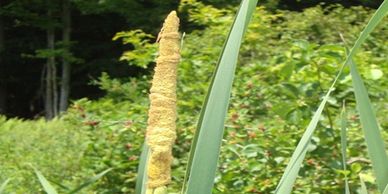Cattails (Typha spp.)
Cattail

Recognize the familiar "corn dog" appearance?
Cattails are known as the "supermarket of the swamp" for their various edible parts.
Just make sure to harvest from "clean" areas. Cattails are really good at absorbing bad things like industrial pollutants.
Young cattails

In spring the young cattail plants (shoots) emerge.
These shoots are harvested by pulling them up from the ground or mud.
The white base of the shoot is edible.
Cattail shoots
Identifying cattail
The white section at the base of the plant is tender and tasty, raw or cooked.
Peel away the tough outer leaves, kind of like a leek.
Identifying cattail
Identifying cattail
Identifying cattail

A word of caution: Cattail can look a bit like iris (not shown).
To be certain you have cattails, always look for the old brown cattail seed heads of last year’s growth. The iris will not have these seed heads. Also, iris stems are flattened at the base, or fan shaped. Cattail stems are more rounded and do not form a fan at the base. Iris is toxic if eaten.
The flower stalk
Identifying cattail
The flower stalk
The male / female flower stalk emerges in spring.
The male section is the polleny part on the top. It is chock full of pollen. The pollen is edible and protein-rich.
Below the male you can see the female section. She will become fertilized by the pollen and turn into the familiar brown "corndog" or "cigar".
The green female part can be boiled and eaten - some say it tastes like corn on the cob.
Pollen
Identifying cattail
The flower stalk

To harvest pollen - Easily collect by shaking the stalks into a bag.
Add a few tablespoons to pancake batter or other baked goods for a nutritious protein boost.